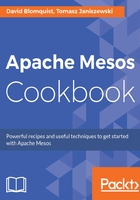
上QQ阅读APP看书,第一时间看更新
Conventions
In this book, you will find a number of text styles that distinguish between different kinds of information. Here are some examples of these styles and an explanation of their meaning.
Code words in text, database table names, folder names, filenames, file extensions, pathnames, dummy URLs, user input, and Twitter handles are shown as follows: " By default, Marathon logs to stdout and syslog."
A block of code is set as follows:
cat <<EOF > /etc/systemd/system/traefik.service
[Unit]
Description=Traefik
Wants=network-online.target
After=network.target network-online.target
[Service]
Restart=on-failure
ExecStart=/usr/bin/traefik
[Install]
WantedBy=multi-user.target
EOF
Any command-line input or output is written as follows:
curl -k https://localhost:8443/ping
New terms and important words are shown in bold. Words that you see on the screen, for example, in menus or dialog boxes, appear in the text like this: " You should also be able to see Marathon listed as a framework in the Mesos UIFrameworks tab."
Warnings or important notes appear like this.
Tips and tricks appear like this.